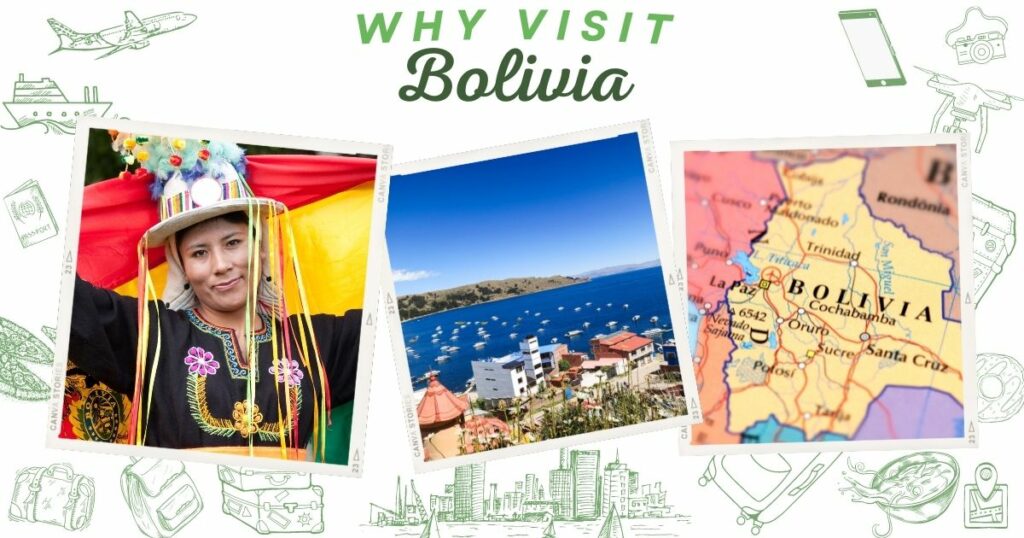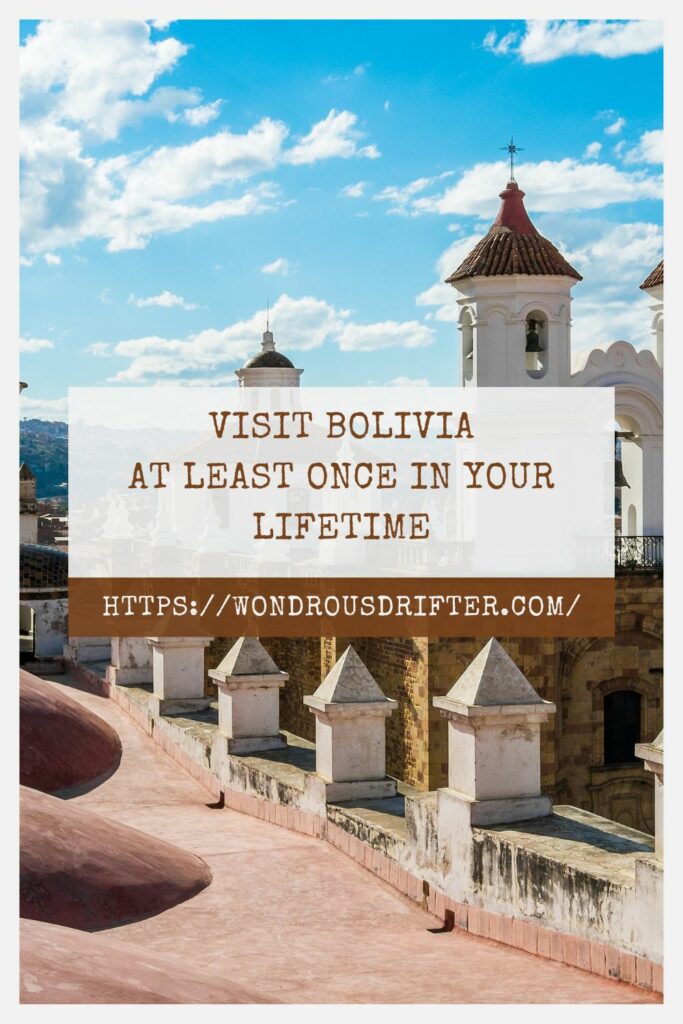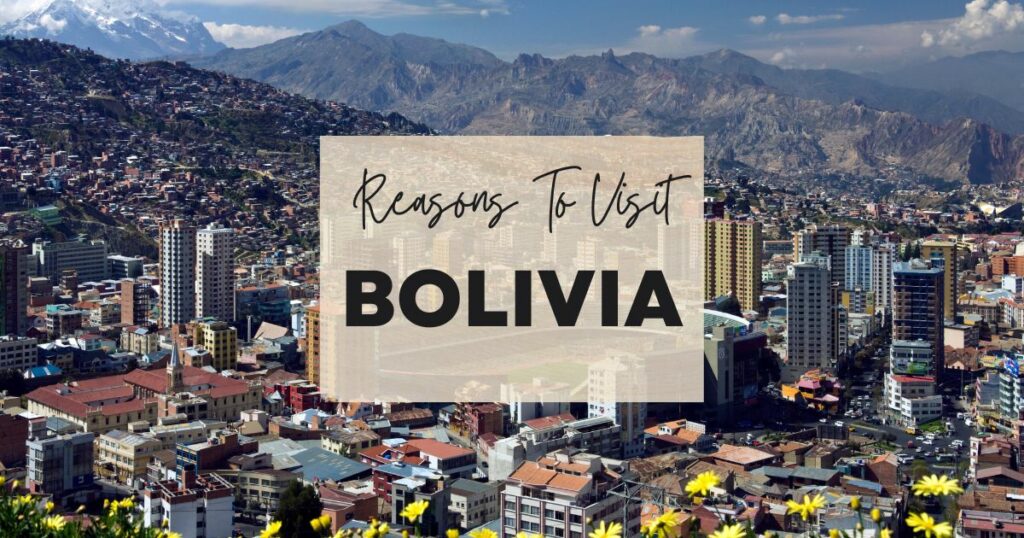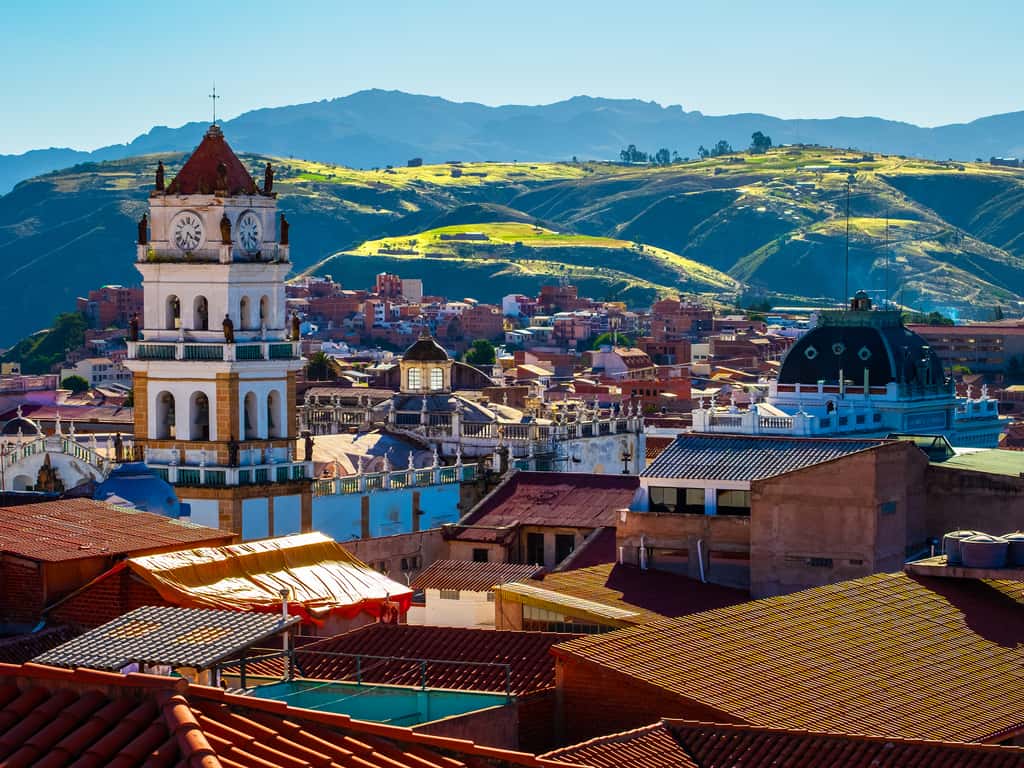Table Of Content
- 100 Reasons to Visit Bolivia: A Tantalizing Journey through Nature, Culture, and Adventure
- Key Takeaways:
- Nature’s Paradise: Awe-Inspiring Landscapes
- Culture Unveiled: Rich Heritage and Traditions
- Thrilling Adventures: Pump Up Your Adrenaline
- Culinary Delights: A Gastronomic Journey
- Captivating Markets: Vibrant Colors and Crafts
- Fun Activities: Making Memories in Bolivia
- Historical Marvels: Stepping into the Past
- Wildlife Encounters: Nature’s Finest
- Hidden Gems: Off the Beaten Path
- Art and Architecture: Masterpieces Galore
- Why go to Bolivia?
- What is Bolivia famous for?
- Fun Facts about Bolivia
- How big is Bolivia?
- When is the best time to visit Bolivia?
- How many days do you need to see Bolivia?
- What is the cheapest time to go to Bolivia?
- Is Bolivia an expensive place to visit?
- How to save money when visiting Bolivia?
- What food (and drinks) is Bolivia known for?
- Is Bolivia safe to visit?
- What is the best way to get around in Bolivia?
- What are the neighborhoods or areas I should stay in when I visit Bolivia?
- What are the best neighborhoods or areas for food?
- What are the best neighborhoods or areas for shopping?
- What should I do on my first trip to Bolivia?
- Is Bolivia a good place for solo travel?
- Is Bolivia a good place to visit for a family with kids?
- Is Bolivia a good place for couples?
- What are the best annual events in Bolivia?
100 Reasons to Visit Bolivia: A Tantalizing Journey through Nature, Culture, and Adventure
Welcome to Bolivia, a mesmerizing nation nestled in the heart of South America. With its breathtaking landscapes, vibrant culture, and thrilling adventures, Bolivia offers you an unforgettable travel experience like no other.
Whether you are a nature lover, history enthusiast, or an adrenaline junkie, this diverse country has something to cater to every traveler’s taste. From the towering peaks of the Andes to the vast expanse of the Amazon rainforest, let us take you on a virtual tour of 100 reasons why you must visit Bolivia at least once in your lifetime.
Key Takeaways:
- Immerse yourself in Bolivia’s rich history and cultural heritage
- Discover the awe-inspiring natural wonders, from the world’s highest capital city to the otherworldly landscapes of the Uyuni Salt Flats
- Embark on thrilling adventures, including hiking, mountain biking, and wildlife spotting
- Indulge in the tantalizing flavors of Bolivian cuisine and traditional drinks
- Explore the unique markets and artisan crafts, offering a glimpse into Bolivia’s vibrant culture
Nature’s Paradise: Awe-Inspiring Landscapes
1. Salar de Uyuni: Lose yourself in the mesmerizing vastness of the largest salt flat in the world, a surreal landscape that mirrors the sky.
2. Lake Titicaca: Marvel at the world’s highest navigable lake, dotted with mystical islands and home to indigenous communities preserving their ancient traditions.
3. Andes Mountains: Trek along the magnificent Andes, witnessing breathtaking vistas and conquering peaks like Illimani and Huayna Potosi.
4. Madidi National Park: Delve into the heart of the Amazon rainforest, encountering exotic wildlife, vibrant bird species, and lush foliage.
5. Yungas Road: Brave the legendary “Death Road” on a thrilling mountain biking adventure, surrounded by stunning cliffs and cloud forests.
6. Toro Toro National Park: Uncover the geological wonders of this park, where you can explore limestone caves, dinosaur footprints, and beautiful canyons.
7. Amazon Basin: Venture into the Bolivian Amazon, where you can embark on unforgettable wildlife safaris and immerse yourself in indigenous culture.
8. Valley of the Moon: Discover a lunar-like landscape near La Paz, with its unique rock formations sculpted by wind and rain over millions of years.
9. Torotoro Dinosaur Tracks: Witness the footprints of long-extinct giants, preserved in the clay beds of Torotoro National Park.
10. Cotapata National Park: Hike through ancient forests, rich in biodiversity, and encounter elusive wildlife such as spectacled bears and jaguars.
Culture Unveiled: Rich Heritage and Traditions
11. Tiwanaku: Step back in time and explore the ruins of the ancient Tiwanaku civilization, a UNESCO World Heritage Site.
12. La Paz Witches’ Market: Experience the mystical atmosphere of this vibrant market, offering potions, talismans, and traditional remedies.
13. Potosi Silver Mines: Descend into the depths of the Cerro Rico mountain to witness the harsh reality of Bolivia’s colonial silver mining history.
14. Sucre: Immerse yourself in Bolivia’s constitutional capital, known for its colonial architecture, charming white buildings, and vibrant festivals.
15. Oruro Carnival: Witness the vibrant Oruro Carnival, recognized by UNESCO as a “Masterpiece of the Oral and Intangible Heritage of Humanity.”
16. Indigenous Communities: Visit remote Andean villages such as Tarabuco and Copacabana, where you can experience the rich traditions and customs of Bolivia’s indigenous communities.
17. Charangos and Panpipes: Listen to the enchanting sounds of traditional Bolivian musical instruments, such as the charango and panpipes.
18. Cholitas Wrestling: Be amazed by the spectacle of Cholitas, indigenous Bolivian women, showcasing their wrestling skills in vibrant traditional attire.
19. Festival of Alasitas: Participate in this unique festival in La Paz, where miniature objects are bought and blessed to bring good luck and prosperity.
20. Museums and Art Galleries: Explore Bolivia’s rich artistic heritage and history through museums like the National Museum of Ethnography and Folklore and the Museum of Contemporary Art.
Thrilling Adventures: Pump Up Your Adrenaline
21. Huayna Potosi Climb: Challenge yourself with a mountaineering expedition and reach the summit of Huayna Potosi, a popular peak for novice climbers.
22. Mountain Biking on the Death Road: Gear up for an adrenaline-fueled mountain biking adventure on the infamous Death Road, an adrenaline junkie’s paradise.
23. Whitewater Rafting: Navigate the exhilarating rapids of the Rio Tuichi or Rio Coroico for an unforgettable rafting experience.
24. Paragliding in La Paz: Soar through the skies of La Paz, enjoying panoramic views of the city and surrounding mountains.
25. Sandboarding in the Desert: Experience the thrill of sandboarding down the majestic dunes of the Uyuni Salt Flats, a unique adventure in a surreal setting.
26. Canopy Tours: Zip-line through lush forests, getting a bird’s-eye view of Bolivia’s stunning landscapes.
27. Rock Climbing: Test your climbing skills on the sheer rock faces of El Penon or La Higuera, surrounded by awe-inspiring scenery.
28. Jungle Safaris: Embark on thrilling jungle safaris in Madidi National Park, where you can spot jaguars, monkeys, and vibrant bird species.
29. Caving in Torotoro National Park: Explore the underground wonders of Torotoro, navigating through intricate cave systems and subterranean formations.
30. Horseback Riding in Tupiza: Saddle up and embark on a scenic horseback riding adventure through the stunning landscapes of Tupiza.
Culinary Delights: A Gastronomic Journey
31. Salteñas: Indulge in Bolivia’s beloved savory pastries, filled with juicy meat, vegetables, and a burst of flavors.
32. Api with Pastel: Savor a traditional Bolivian breakfast of warm Api, a spiced corn drink, paired with scrumptious Pastel, a fried pastry filled with cheese.
33. Silpancho: Delight in this classic Bolivian dish, featuring a thin breaded beef cutlet served over rice, potatoes, and topped with a fried egg.
34. Chuflay: Quench your thirst with this refreshing Bolivian cocktail, mixing Singani (a local distilled spirit), ginger ale, and a squeeze of lime.
35. Pique a lo Macho: Indulge in this hearty and spicy dish loaded with beef, sausage, onions, tomatoes, and topped with a fried egg.
36. Quinoa: Discover the diversity of quinoa, Bolivia’s “superfood,” in various dishes like salads, soups, and stuffed peppers.
37. Sopa de Mani: Warm your soul with this creamy peanut soup, a traditional Bolivian favorite often served with noodles and beef.
38. Chicha: Explore Bolivia’s traditional beverage made from fermented maize, available in both non-alcoholic and alcoholic versions.
39. Majadito: Indulge in this flavorsome rice dish cooked with diced beef, tomatoes, onions, and spices, typically served with a fried egg on top.
40. Bolivian Coffee: Relish the rich flavors of Bolivian-grown coffee beans, renowned for their exceptional quality and unique taste.
Captivating Markets: Vibrant Colors and Crafts
41. Mercado de las Brujas (Witches’ Market): Immerse yourself in the mystical atmosphere of La Paz’s Witches’ Market, where you can find traditional remedies, talismans, and exotic potions.
42. Mercado Rodriguez: Dive into the bustling chaos of Cochabamba’s largest market, featuring a vibrant display of fruits, vegetables, and tasty street food.
43. Tarabuco Market: Witness the explosion of colors at Tarabuco’s Sunday market, showcasing traditional textiles, blankets, and intricate weavings.
44. Mercado Campesino: Explore this sprawling market in Sucre, offering a vast array of fresh produce, spices, and artisan crafts.
45. Sagarnaga Street Market: Stroll along this vibrant market street in La Paz, brimming with handcrafted textiles, jewelry, and souvenirs.
46. Potosi Miner’s Market: Experience the unique atmosphere of the Miner’s Market, offering an assortment of supplies and offerings for the miners working in the Cerro Rico.
47. Santa Cruz Artisan Market: Discover a treasure trove of unique handmade crafts, ranging from pottery and wood carvings to jewelry and leather goods.
48. Patacamaya Market: Immerse yourself in the colorful chaos of Patacamaya’s bustling market, known for its vibrant textiles and traditional clothing.
49. Mercado Negro: Get lost in the labyrinthine alleys of Oruro’s Mercado Negro, where you can find everything from fresh produce to electronics.
50. Plaza Murillo Street Vendors: Explore the vibrant street stalls surrounding La Paz’s Plaza Murillo, offering an assortment of handicrafts and traditional products.
Fun Activities: Making Memories in Bolivia
51. Take a traditional woven boat ride across Lake Titicaca and visit the Uros floating islands.
52. Attend the Festival of the Great Power in La Paz, a raucous celebration of music, dance, and religious devotion.
53. Marvel at the bizarre and whimsical architecture of La Paz’s El Alto neighborhood, with its multi-colored buildings and unique designs.
54. Attend a Bolivian football match and experience the passion and enthusiasm of local fans.
55. Visit the city of Sucre during the Semana Santa (Holy Week) celebrations, witnessing the vibrant processions and religious ceremonies.
56. Explore the San Ignacio de Moxos Jesuit Mission, a UNESCO World Heritage Site, and immerse yourself in the region’s colonial history.
57. Discover the ancient rock paintings of the El Fuerte de Samaipata archaeological site, offering insights into Bolivia’s pre-Columbian civilizations.
58. Visit the Inti Raymi festival in Copacabana, where ancient Inca traditions merge with Catholicism in a colorful display of dance and music.
59. Attend a traditional Bolivian Pachamama ceremony, honoring Mother Earth and seeking blessings for fertility and prosperity.
60. Take part in a homestay with an indigenous community, experiencing their daily life, traditions, and cuisine firsthand.
Historical Marvels: Stepping into the Past
61. Casa de la Libertad: Step into the birthplace of Bolivia’s independence at the Casa de la Libertad in Sucre, where the country’s first constitution was signed.
62. Jesuit Missions of the Chiquitos: Explore the beautifully preserved Jesuit missions in Santa Cruz, showcasing a unique blend of European and indigenous architectural styles.
63. El Alto Cable Car: Take a ride on the world’s highest urban cable car system, connecting El Alto to La Paz, and enjoy breathtaking views of the city.
64. Museum of Ethnography and Folklore: Dive into Bolivia’s diverse cultural heritage through the extensive collection of artifacts and exhibits at this La Paz museum.
65. Tiwanaku Gate of the Sun: Admire the intricate stone carvings and ancient structures at the Gate of the Sun, a testament to the Tiwanaku civilization’s ingenuity.
66. San Francisco Church and Convent: Explore the stunning architecture and ornate interiors of this historic church in Sucre, a masterpiece of colonial art and design.
67. National Museum of Archaeology: Journey through Bolivia’s ancient past as you explore the extensive collection of artifacts, including ceramics and textiles.
68. Royal Mint of Potosi: Discover the fascinating history of Potosi’s silver mining industry and witness the Mint’s colonial-era machinery.
69. Bolivian National Congress: Take a guided tour of the legislative chambers in La Paz and learn about Bolivia’s political history and governance.
70. Palacio Portales: Marvel at the opulence of this historic mansion in Cochabamba, once belonging to Simón Patiño, the “King of Tin.”
Wildlife Encounters: Nature’s Finest
71. Colibri Cloud Forest: Get up close and personal with over 300 species of hummingbirds in this biodiverse cloud forest near Coroico.
72. Amboro National Park: Embark on a wildlife safari in this protected area, home to jaguars, tapirs, and vibrant bird species.
73. Eduardo Avaroa Andean Fauna National Reserve: Spot elusive Andean wildlife, including flamingos, vicuñas, and the endangered Andean cat.
74. Pantanal Boliviano: Explore Bolivia’s part of the vast Pantanal wetlands, hosting an incredible array of bird species and aquatic life.
75. Machia Biological Park: Volunteer or visit this wildlife refuge in Cochabamba and interact with rescued monkeys and other native species.
76. Laguna Colorada: Admire the breathtaking red hues of this high-altitude lake, home to flocks of flamingos and other Andean waterbirds.
77. Carrasco National Park: Trek through this biodiverse park, spotting playful monkeys, colorful toucans, and rare orchid species.
78. Noel Kempff Mercado National Park: Discover the pristine rainforests of this national park, teeming with diverse wildlife including jaguars, tapirs, and anacondas.
79. Laguna Verde: Marvel at the vibrant green waters of this stunning lake, nestled at the foot of the Licancabur Volcano.
80. Calilegua National Park: Explore the lush cloud forests of this Argentine-Bolivian national park, home to hummingbirds, monkeys, and elusive jaguars.
Hidden Gems: Off the Beaten Path
81. Toro Toro Caverns: Navigate through a labyrinth of underground caves in Toro Toro National Park, home to unique limestone formations and stalactites.
82. Yumani Stairs: Climb the ancient Inca steps on Isla del Sol, located in Lake Titicaca, and enjoy panoramic views of the lake and surrounding landscapes.
83. Samaipata Waterfalls: Take a refreshing dip in the cascading waters of these hidden gems, tucked away in the lush forests near Samaipata.
84. Quime: Explore the charming town of Quime, nestled in the Bolivian highlands, and immerse yourself in its peaceful atmosphere and stunning vistas.
85. Tariquia Flora and Fauna National Reserve: Embark on a trek through this little-known reserve, spotting unique plant species and elusive wildlife.
86. Incallajta Ruins: Discover the ruins of an ancient Inca stronghold, hidden deep within Bolivia’s rugged landscapes.
87. San Jose de Chiquitos: Immerse yourself in the tranquility of this colonial town, adorned with red sandstone architecture and surrounded by lush vegetation.
88. Apolo: Escape the crowds and explore the remote town of Apolo, where you can witness traditional dances and ceremonies of indigenous communities.
89. Uyuni’s Train Cemetery: Wander through the rusting hulks of abandoned trains, a hauntingly beautiful sight amidst the barren salt flats.
90. Toropalca Hot Springs: Relax in the natural hot springs of Toropalca, surrounded by stunning mountain scenery.
Art and Architecture: Masterpieces Galore
91. Museo Nacional de Arte: Admire Bolivia’s rich art heritage, spanning from colonial religious art to contemporary masterpieces.
92. San Lorenzo de Tarqui Church: Explore the unique architecture of this church in Tarabuco, characterized by its combination of indigenous and Baroque styles.
93. Santa Clara Church and Convent: Visit this architectural gem in Potosi, featuring intricate woodwork and breathtaking frescoes.
94. Church of San Francisco: Revel in the splendor of this 16th-century church in La Paz, known for its ornate Baroque facade and interior decorations.
95. Church of San Ignacio de Velasco: Marvel at the ornate decorations and indigenous-inspired motifs adorning this Jesuit mission church.
96. San Pedro Church: Explore the historic San Pedro Church in Sucre, known for its impressive colonial facade and stunning interior artwork.
97. Casa Dorada: Step into this meticulously restored mansion in Sucre, showcasing the opulence and grandeur of Bolivia’s colonial past.
98. Church of the Society of Jesus: Admire the intricate facade and ornate interiors of this Jesuit church in Sucre, a masterpiece of colonial architecture.
99. Palacio Quemado: Discover the elegant architecture of the Bolivian Government Palace in La Paz, where the president resides and conducts official business.
100. Church of Santo Domingo: Visit this UNESCO World Heritage Site in Sucre, featuring a blend of Baroque, Mestizo, and indigenous architectural styles.
With its staggering natural beauty, cultural richness, and adrenaline-inducing adventures, Bolivia promises an extraordinary journey through diverse landscapes and enchanting traditions. Unlock the wonders of this South American gem, and let Bolivia cast its spell on you. Start planning your unforgettable expedition and embark on a voyage of a lifetime.
Why go to Bolivia?
You must visit Bolivia at least once in your lifetime because stunning landscapes await you. It includes snow-covered peaks, desert stretches, lush jungles, and glacial lakes at high elevations. Among the Amazonian animals, you can see in Bolivia are crocodiles, monkeys, dolphins, snakes, and spiders. Those looking to wander off the beaten path can do so in style in this beautifully authentic country.
- Amazon Rainforest
- Bolivia
- Cable Car in La Paz
- Cycle Death Road
- Coroico
- Cholita Wrestling
- Cal Ockr’o
- Coca Museum
- Cordillera Real
- El Mercado de las Brujas
- Isla Del Sol
- Jesuit Missions
- Lake Titicaca
- Laguna Colorada
- Madidi National Park, Bolivia
- Oruro Carnival, Bolivia
- Potosi
- Salar de Uyuni
- Sucre
- Samaipata
- Santa Cruz
- Tiwanaku
- Tupiza
- Toro Toro National Park, Bolivia
- Valle de la Luna, Bolivia
What is Bolivia famous for?
Bolivia is famous for its high altitudes, llamas, and dangerous jungle routes. Bolivia is also recognized for its snow-capped mountains, vast salt flats, and incredible diversity.
Fun Facts about Bolivia
- More than 30 official languages are spoken in Bolivia.
- Bolivia is home to three of the six flamingo species that exist worldwide.
- It is common knowledge that La Paz is Bolivia’s capital city, but that isn’t exactly correct.
- La Paz has over one million residents as the tallest city in the world.
- The Salar de Uyuni is the giant mirror in the world.

How big is Bolivia?
Bolivia is about 1.099 square km or 0.424 square miles in size.
When is the best time to visit Bolivia?
The best time to visit Bolivia is the months of May to October.
How many days do you need to see Bolivia?
There’s no reason to rush when you have three weeks to see everything Bolivia offers. Selva Boliviana should be at the top of your list of things to see while visiting the city.
What is the cheapest time to go to Bolivia?
The low season (flights) to visit Bolivia is in the month of April.
Is Bolivia an expensive place to visit?
Bolivia has a well-deserved reputation as one of South America’s most budget-friendly tourist destinations. For years, the low cost of travel to Bolivia has made it a go-to destination for backpackers and adventurers.
How to save money when visiting Bolivia?
The best ways to save money when visiting Bolivia are:
- Stay in hostels instead of hotels.
- Use public buses as a mode of transport.
- Eat at local restaurants
- Join group tours
What food (and drinks) is Bolivia known for?
- Saltena refers to an empanada baked in the oven with beef or chicken and a mixture of olives, potatoes, and other vegetables, as well as hard-boiled eggs, raisins, and spices.
- Té con té – or tea with tea, is a warming Bolivian beverage. Singani is a solid and fragrant Bolivian brandy made from grapes called Muscat of Alexandria. Cinnamon, lime, and tea are also mixed in with it.
Things you need to eat in Bolivia before you die:
- Anticuchos
- Cuñapé
- Singani
- Lipeña

Is Bolivia safe to visit?
Travelers can feel safe and secure in Bolivia. Most crimes against tourists occur in popular destinations like La Paz and other large towns. You should know that street crime is expected, so you don’t get robbed or pickpocketed while on vacation in tourist areas, restaurants, shops, and public transportation.
What is the best way to get around in Bolivia?
The best way to get around in Bolivia are:
- By bus
- Taxi / Uber
- Camiones (Trucks)
What are the neighborhoods or areas I should stay in when I visit Bolivia?
The best areas you should stay in when visiting Bolivia are:
- La Paz
- Sopocachi
- El Centro
- Copacabana
What are the best neighborhoods or areas for food?
The best areas for food and drinks when visiting Bolivia are:
- La Paz
- Cochabamba
- Sucre
- Lake Titicaca
What are the best neighborhoods or areas for shopping?
The best areas for shopping when visiting Bolivia are:
- La Mancha
- Flea and Street Markets
- Ventura Mall
- Calle Sagarnaga & Calle Linares
What should I do on my first trip to Bolivia?
If you are visiting Bolivia for the first time, you can get a taste of everything, from the most basic to the most luxurious. Madidi National Park is the best spot in Bolivia to see the magnificent Amazon River, whether hiking through the rainforest or checking out the wildlife. Be aware that public transportation from big cities might take several hours, especially during the rainy season.
Is Bolivia a good place for solo travel?
When traveling solo, you’ll come across a variety of natural treasures. Even though you’ll be exposed to poverty and crime in the big towns, you’ll be able to enjoy a wide variety of natural wonders in Bolivia. These include mountains, volcanoes, salt flats and geysers, and the world’s most dangerous road. The experience of traveling alone in Bolivia is one that you will never forget.
Is Bolivia a good place to visit for a family with kids?
When visiting Bolivia as a family with kids, you have a great choice because there are so many fun activities to enjoy together. The world-class ski slopes in La Paz are a significant draw for visitors to the city. With children, mountain resorts can be a fun place to visit. Snow Rush Bolivia is one of the top resorts, and sporting goods rental outlets and a ski school can be found in the area. The fact that there are cozy restaurants and cafes near the resort will make this trip even better.
Is Bolivia a good place for couples?
When visiting Bolivia as a couple, you must visit the Island of the Sun. It is one of Bolivia’s most famous and beautiful sites and is located around a peaceful lake. The bustle of Bolivian life is a world apart from this remote location. You can watch the sunset over the lake as you dine at the famed Las Velas restaurant located in a quiet cove.
What are the best annual events in Bolivia?
The best annual events in Bolivia that you cannot miss are
- Oruro in the month of February
- Semana Santa in April
- Fiesta de la Cruz in May
- Exaltacion de la Santa Cruz in September
- Navidad in the month of December


